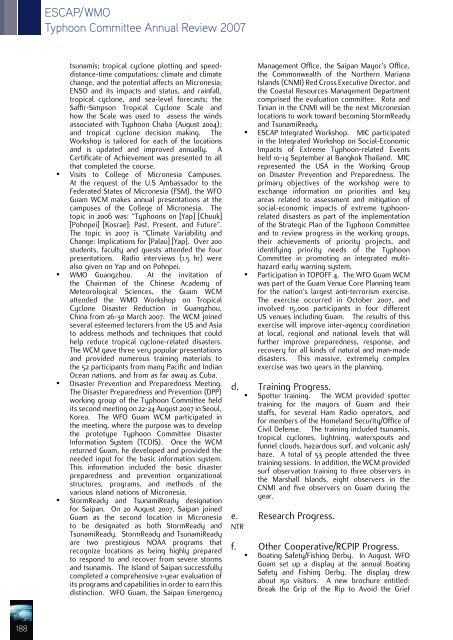200 - Typhoon Committee
200 - Typhoon Committee
200 - Typhoon Committee
Create successful ePaper yourself
Turn your PDF publications into a flip-book with our unique Google optimized e-Paper software.
ESCAP/WMO<br />
<strong>Typhoon</strong> <strong>Committee</strong> Annual Review <strong>200</strong>7<br />
tsunamis; tropical cyclone plotting and speeddistance-time<br />
computations; climate and climate<br />
change, and the potential affects on Micronesia;<br />
ENSO and its impacts and status, and rainfall,<br />
tropical cyclone, and sea-level forecasts; the<br />
Saffir-Simpson Tropical Cyclone Scale and<br />
how the Scale was used to assess the winds<br />
associated with <strong>Typhoon</strong> Chaba (August <strong>200</strong>4);<br />
and tropical cyclone decision making. The<br />
Workshop is tailored for each of the locations<br />
and is updated and improved annually. A<br />
Certificate of Achievement was presented to all<br />
that completed the course.<br />
• Visits to College of Micronesia Campuses.<br />
At the request of the U.S Ambassador to the<br />
Federated States of Micronesia (FSM), the WFO<br />
Guam WCM makes annual presentations at the<br />
campuses of the College of Micronesia. The<br />
topic in <strong>200</strong>6 was: “<strong>Typhoon</strong>s on [Yap] [Chuuk]<br />
[Pohnpei] [Kosrae]: Past, Present, and Future”.<br />
The topic in <strong>200</strong>7 is “Climate Variability and<br />
Change: Implications for [Palau] [Yap]. Over <strong>200</strong><br />
students, faculty and guests attended the four<br />
presentations. Radio interviews (1.5 hr) were<br />
also given on Yap and on Pohnpei.<br />
• WMO Guangzhou. At the invitation of<br />
the Chairman of the Chinese Academy of<br />
Meteorological Sciences, the Guam WCM<br />
attended the WMO Workshop on Tropical<br />
Cyclone Disaster Reduction in Guangzhou,<br />
China from 26-30 March <strong>200</strong>7. The WCM joined<br />
several esteemed lecturers from the US and Asia<br />
to address methods and techniques that could<br />
help reduce tropical cyclone-related disasters.<br />
The WCM gave three very popular presentations<br />
and provided numerous training materials to<br />
the 52 participants from many Pacific and Indian<br />
Ocean nations, and from as far away as Cuba.<br />
• Disaster Prevention and Preparedness Meeting.<br />
The Disaster Preparedness and Prevention (DPP)<br />
working group of the <strong>Typhoon</strong> <strong>Committee</strong> held<br />
its second meeting on 22-24 August <strong>200</strong>7 in Seoul,<br />
Korea. The WFO Guam WCM participated in<br />
the meeting, where the purpose was to develop<br />
the prototype <strong>Typhoon</strong> <strong>Committee</strong> Disaster<br />
Information System (TCDIS). Once the WCM<br />
returned Guam, he developed and provided the<br />
needed input for the basic information system.<br />
This information included the basic disaster<br />
preparedness and prevention organizational<br />
structures, programs, and methods of the<br />
various island nations of Micronesia.<br />
• StormReady and TsunamiReady designation<br />
for Saipan. On 20 August <strong>200</strong>7, Saipan joined<br />
Guam as the second location in Micronesia<br />
to be designated as both StormReady and<br />
TsunamiReady. StormReady and TsunamiReady<br />
are two prestigious NOAA programs that<br />
recognize locations as being highly prepared<br />
to respond to and recover from severe storms<br />
and tsunamis. The Island of Saipan successfully<br />
completed a comprehensive 1-year evaluation of<br />
its programs and capabilities in order to earn this<br />
distinction. WFO Guam, the Saipan Emergency<br />
Management Office, the Saipan Mayor’s Office,<br />
the Commonwealth of the Northern Mariana<br />
Islands (CNMI) Red Cross Executive Director, and<br />
the Coastal Resources Management Department<br />
comprised the evaluation committee. Rota and<br />
Tinian in the CNMI will be the next Micronesian<br />
locations to work toward becoming StormReady<br />
and TsunamiReady.<br />
• ESCAP Integrated Workshop. MIC participated<br />
in the Integrated Workshop on Social-Economic<br />
Impacts of Extreme <strong>Typhoon</strong>-related Events<br />
held 10-14 September at Bangkok Thailand. MIC<br />
represented the USA in the Working Group<br />
on Disaster Prevention and Preparedness. The<br />
primary objectives of the workshop were to<br />
exchange information on priorities and key<br />
areas related to assessment and mitigation of<br />
social-economic impacts of extreme typhoonrelated<br />
disasters as part of the implementation<br />
of the Strategic Plan of the <strong>Typhoon</strong> <strong>Committee</strong><br />
and to review progress in the working groups,<br />
their achievements of priority projects, and<br />
identifying priority needs of the <strong>Typhoon</strong><br />
<strong>Committee</strong> in promoting an integrated multihazard<br />
early warning system.<br />
• Participation in TOPOFF 4. The WFO Guam WCM<br />
was part of the Guam Venue Core Planning team<br />
for the nation’s largest anti-terrorism exercise.<br />
The exercise occurred in October <strong>200</strong>7, and<br />
involved 15,000 participants in four different<br />
US venues including Guam. The results of this<br />
exercise will improve inter-agency coordination<br />
at local, regional and national levels that will<br />
further improve preparedness, response, and<br />
recovery for all kinds of natural and man-made<br />
disasters. This massive, extremely complex<br />
exercise was two years in the planning.<br />
d. Training Progress.<br />
• Spotter training. The WCM provided spotter<br />
training for the mayors of Guam and their<br />
staffs, for several Ham Radio operators, and<br />
for members of the Homeland Security/Office of<br />
Civil Defense. The training included tsunamis,<br />
tropical cyclones, lightning, waterspouts and<br />
funnel clouds, hazardous surf, and volcanic ash/<br />
haze. A total of 53 people attended the three<br />
training sessions. In addition, the WCM provided<br />
surf observation training to three observers in<br />
the Marshall Islands, eight observers in the<br />
CNMI and five observers on Guam during the<br />
year.<br />
e. Research Progress.<br />
NTR<br />
f. Other Cooperative/RCPIP Progress.<br />
• Boating Safety/Fishing Derby. In August, WFO<br />
Guam set up a display at the annual Boating<br />
Safety and Fishing Derby. The display drew<br />
about 150 visitors. A new brochure entitled:<br />
Break the Grip of the Rip to Avoid the Grief<br />
188
















